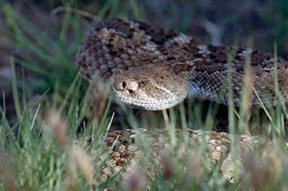264 bites recorded statewide in 2020
 Phoenix AZ (April 8, 2021) – With more people getting outdoors to take advantage of the state’s warm, spring weather, it’s important to keep in mind that 13 species of rattlesnakes also call Arizona home.
Phoenix AZ (April 8, 2021) – With more people getting outdoors to take advantage of the state’s warm, spring weather, it’s important to keep in mind that 13 species of rattlesnakes also call Arizona home.
Depending on location, the species that are encountered most often are the Western diamondback, sidewinder, Mojave and black-tailed rattlesnakes.
“Arizona has more rattlesnake species than any other state, and we can all celebrate that amazing biodiversity,” said Thomas Jones, amphibians and reptiles program manager for the Arizona Game and Fish Department.
 In warm desert areas, rattlesnakes are most active from March through October. During the spring, it’s not uncommon for rattlesnakes to be out during daylight hours. As the days become increasingly hot, though, usually around early May, rattlesnakes tend to move around more at night.
In warm desert areas, rattlesnakes are most active from March through October. During the spring, it’s not uncommon for rattlesnakes to be out during daylight hours. As the days become increasingly hot, though, usually around early May, rattlesnakes tend to move around more at night.
April is typically an active month for rattlesnakes, as they are coming out of hibernation. “We want people to know that there is a higher than average chance that they might encounter a rattlesnake when they are out recreating,” Jones said.
Statewide, 35 bites were reported last April to the Arizona Poison and Drug Information Center.
Rattlesnakes can easily blend in with their surroundings, so a person should always be mindful where they are placing their feet and hands. Carry a flashlight at night, especially on warmer nights when rattlesnakes can be most active.
Stay on the trail
- Remain calm and reassure the victim.
- Call 911 and seek medical attention without delay.
- Remove all jewelry, watches, etc. from the affected area.
- Immobilize the extremity and keep at level below the heart.
- Decrease total body activity as is feasible.
- Do NOT apply ice to the bite area.
- Do NOT use an incision of any kind.
- Do NOT use a constriction band or tourniquet.
- Do NOT administer alcohol or drugs.
- Do NOT use electric shock treatment.



